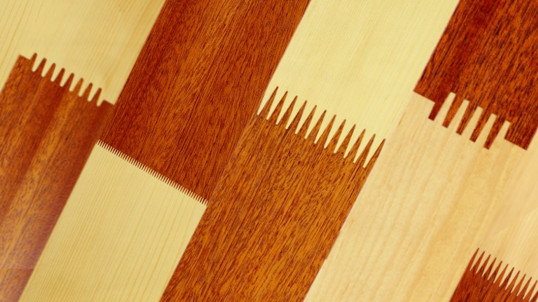Finger joint on:
[Wikipedia]
[Google]
[Amazon]
 A finger joint, also known as a comb joint, is a
A finger joint, also known as a comb joint, is a
{{Woodworking Joinery de:Holzverbindung#Zinkung_und_Gratung
 A finger joint, also known as a comb joint, is a
A finger joint, also known as a comb joint, is a woodworking joint
Joinery is a part of woodworking that involves joining pieces of wood, engineered lumber, or synthetic substitutes (such as laminate), to produce more complex items. Some woodworking joints employ mechanical fasteners, bindings, or adhesives, ...
made by cutting a set of complementary, interlocking profiles in two pieces of wood
Wood is a structural tissue/material found as xylem in the stems and roots of trees and other woody plants. It is an organic materiala natural composite of cellulosic fibers that are strong in tension and embedded in a matrix of lignin t ...
, which are then glued. The cross-section of the joint resembles the interlocking of fingers between two hands, hence the name "finger joint". The sides of each profile increases the surface area for gluing, resulting in a strong bond, stronger than a butt joint
A butt joint is a joinery, wood joint in which the end of a piece of material is simply placed (or “butted”) against another piece. The butt joint is the simplest joint. An unreinforced butt joint is also the weakest joint, as it provides a ...
but not very visually appealing. Finger joints are regularly confused with box joints, which are used for corners of boxes or box-like constructions.
Creation
Finger joints are generally created by using identical profiles for both pieces. They are made complementary by rotation or translation of the tool with respect to the workpiece. Typically a finger router bit is used, but spindle moulders can also be used. Manual cutting of finger joints is time-consuming and error prone hence rarely done except in craft pieces.Applications
A tapered or scarfed finger joint is the most common joint used to form long pieces of lumber from solid boards; the result is finger-jointedlumber
Lumber is wood that has been processed into uniform and useful sizes (dimensional lumber), including beams and planks or boards. Lumber is mainly used for construction framing, as well as finishing (floors, wall panels, window frames). ...
.
The finger joint can also be valuable when creating baseboard
In architecture, a baseboard (also called skirting board, skirting, wainscoting, mopboard, trim, floor molding, or base molding) is usually wooden, MDF or vinyl board covering the lowest part of an interior wall. Its purpose is to cover the ...
s, moulding or trim, and can be used in such things as floor board
Flooring is the general term for a permanent covering of a floor, or for the work of installing such a floor covering. Floor covering is a term to generically describe any finish material applied over a floor structure to provide a walking surface. ...
s, and door
A door is a hinged or otherwise movable barrier that allows ingress (entry) into and egress (exit) from an enclosure. The created opening in the wall is a ''doorway'' or ''portal''. A door's essential and primary purpose is to provide securit ...
construction.
See also
*Dovetail joint
A dovetail joint or simply dovetail is a joinery technique most commonly used in woodworking joinery (carpentry), including furniture, cabinets, log buildings, and traditional timber framing. Noted for its resistance to being pulled apart, a ...
* Miter joint
A miter joint (mitre in British English) is a joint made by cutting each of two parts to be joined, across the main surface, usually at a 45° angle, to form a corner, usually to form a 90° angle, though it can comprise any angle greater than 0 ...
* Box joint
A box joint is a woodworking joint made by cutting a set of complementary, interlocking profiles in two pieces of wood, which are then joined (usually) at right angles, usually glued. The glued box joint has a high glued surface area resulting i ...
* Lap joint
References
https://www.nrcan.gc.ca/forests{{Woodworking Joinery de:Holzverbindung#Zinkung_und_Gratung